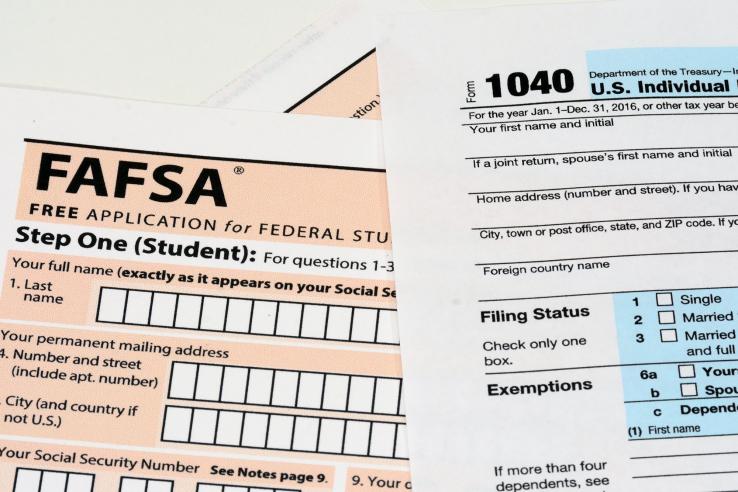
Making the transition to college: Student voices

The college application and enrollment process in the United States is complex. For aspiring first-generation college students, that complexity can overwhelm even the best intentions to enroll in and finish college. However, there is emerging evidence that personalized assistance on college applications and matriculation requirements can help students overcome these initial barriers in attaining a college degree.
In this third blog post in our three-part series on access to college, two current first-generation college students describe their experiences navigating the application and enrollment process. Both students received support from uAspire, a Boston-based nonprofit organization that offers college-intending high school students personalized support through text messaging and peer mentoring.
Myiesha Robateau writes,
My experience with the college application process was very tedious. I am a first-generation student and before I became familiar with uAspire, I had to manage the process alone without help from my parents, since they did not know what to do. On my own, I had difficulty understanding what I should—and should not—be doing throughout the process.
One day, a uAspire counselor named Angela introduced herself to my English Honors high school class. She was very happy to explain her role in supporting us as we went through the college application process.
I met with Angela almost every week, sometimes just to quickly check in about my progress on my college applications. She helped me figure out how to break down the Free Application for Federal Student Aid (FAFSA) form, the College Scholarship Services (CSS) Profile (an application distributed by the College Board allowing students to apply for financial aid), and other financial and non-financial details that I needed to understand in order to complete the necessary paperwork.
Many times I became frustrated with the process and wanted to give up, but Angela gave me inspiration to keep going. My college application experience became much easier with the help of uAspire, and I am eternally grateful for my counselor and the program.
Chloe Wells writes,
Being a first-generation college student, my parents had no idea how to initiate the college application process, nor how they were going to actually finance my education once all of my applications were submitted. I knew that I would have to take my own initiative in navigating the college process, since I didn’t have that much support at home.
Once I completed all of my applications, my next steps were to complete all the documents for financial aid—the FAFSA and the dreaded CSS Profile. I didn’t even know where to start.
Looking for guidance, I went to the college and career center at my high school, where I met my smiling uAspire counselor.
She gave me a detailed sheet of the documents I needed to collect and steps for navigating through the various websites. Before I even left, my counselor had already made a follow-up appointment with me for the following week where she would go over any questions I had and help me submit my first round of paperwork. So I went home, collected my parents’ tax forms, and started to fill out the forms to the best of my ability and left many sections blank that I was unsure of.
When I met a week later with my counselor, she helped me fill out each and every section that I left blank and submitted all of my college documents in her office that very day.
Once I got over the obstacles of starting the financial aid process and collecting information from my parents, I was anxiously waiting for my financial aid packages from each of my schools, and stressed about how my family and I would pay.
But when acceptance letters started coming in my counselor texted me, asking to meet and compare all of my letters. When I walked into her office with my award letters, she had a large spreadsheet open on her computer to help me compare my cost of attendance and loans for each school.
One of the most important pieces was that she helped me understand my aid with great detail so that I would be able to explain it to my parents as well once I decided on a school.
Even after being accepted to college, students often face barriers to matriculation (starting college), including delays in financial aid due to income verification requirements, costs of travelling to campus, and unanticipated fees on tuition bills. Up to twenty percent of recent high school graduates that are accepted to college fail to matriculate, a phenomenon commonly known as “summer melt.”
Ms. Wells further explains how continued personalized assistance from her uAspire counselor supported her during this critical phase:
Guidance from uAspire didn’t end once I put a deposit down for college. A few weeks after graduation, I received a text from another counselor asking if I received my college bill and if I had any questions.
At first I thought that I was fine and understood everything about the tuition that I was paying, but when I saw my first bill I was very confused and panicked since it was the middle of summer and I no longer had any of my high school resources.
But I sent a text to my new counselor, telling her that I had some questions. She asked me to send her pictures of my bill and of all the materials that I had received. She put me at ease by explaining in detail what I would be paying for the fall semester, helping me waive my health insurance costs, and guiding me to the federal loan counseling website.
Even though I had been out of school for two months, I was still receiving help from uAspire and don't know what I would have done without it.
Especially when I received that first tuition bill, I felt helpless because my parents weren't familiar with the billing process, and I only knew so much. But uAspire helped me overcome my barrier of not having much support and never forgot about me. They are still helping me find ways to finance my college education and I will be forever grateful.
Ms Robateau is currently a student at University of Massachusetts at Amherst. Ms. Wells is currently a student at Northeastern University.
This is the third post in a three-part series on improving access to higher education. In the first post, we reviewed major challenges that aspiring students face and introduced findings from randomized evaluations that highlight evidence-based interventions to address these barriers. In the second post, we highlighted a hands-on guide that outlines cost-effective, evidence-based solutions to help more students successfully apply, enroll, and graduate from college.


